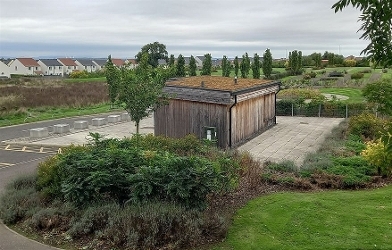Biodiversity and Planning
Due to growing populations in the Central Belt, environmental pressures and threats are priority issues for the council to address. New international binding targets and subsequent climate change and biodiversity-related policies and legislation also aim to halt biodiversity loss and protect, connect and enhance habitats.

National Planning Framework 4
National Planning Framework (NPF)4 (opens new window), was adopted in February 2023, and gives significant weight to the current climate and nature crises - with new national planning policies aiming to halt biodiversity loss and actively promote nature-restoration. The main nature-related policy is Policy 3 - Biodiversity, although it should be noted that many other policies have biodiversity elements. These are material considerations in any new planning applications. When forming proposals for planning applications, applicants should carefully read the from Scottish Government setting out expectations for implementing NPF4 policies that support the cross-cutting outcome 'improving biodiversity'.
West Lothian Planning Guidance
West Lothian Council adopted Planning for Nature (opens new window) in April 2020. This document provides guidance and sets out requirements for planning applicants and agents on wildlife, natural heritage and biodiversity issues to consider when formulating proposals for planning applications.
Although written prior to the adoption of NPF4 (see below) the good practice measures and principles outlined in this document still stand.
As West Lothian Council declared a Nature Emergency in May 2023, a precautionary approach is favoured.
Planning Applications
General Guidance
NatureScot's Developing with Nature (opens new window) guidance has been created to support NPF4 Policy 3c, regarding local development. Potential impacts on biodiversity should be fully considered from the outset, which will help to avoid potential lengthy delays and additional costs further along in the process. All planning applicants must ensure that they have considered the existing ecology on their site and designed the development accordingly - ensuring that the 'mitigation hierarchy' has been followed, with relevant ecological survey information provided and details of any avoidance, mitigation and/or compensation measures required. Nature-based, biodiverse solutions (opens new window) to issues such as surface-water management, boundary features, carbon, health and well-being, traffic calming, etc should be used where possible. When considering species for planting, avoid the widespread use of single species, for example in hedges. Please also note potential invasive species (opens new window) that should be avoided in planting plans.
Ecological Connectivity
Connectivity is a major factor when addressing biodiversity. Each planning application must ensure that habitat fragmentation is avoided, by designing the layout of the development accordingly, and that biodiversity elements are connected with the existing surrounding landscape in some way - either by increasing the size of existing habitats, filling gaps in the surrounding habitats or enhancing connections. Providing habitat connections through a development, enabling the passage of wildlife, is also a key consideration. Please note that foraging habitats are just as important as sheltering habitats when providing for animal species.
Biodiversity enhancement statement
A stand-alone biodiversity enhancement statement must accompany all applications - detailing exactly which biodiversity enhancement measures will be implemented through the development (however large or small - measures should be proportionate) and how these will be managed. As per NatureScot's guidance "It should be clear from the information provided that the measures proposed are additional to what is expected to mitigate the development's impact in line with established good practice and compliance with other policies, and enable the planning authority to be confident that appropriate measures to conserve, restore and enhance biodiversity will be delivered and secured."
To ensure positive effects for biodiversity, West Lothian Council's minimum requirements from NatureScot's Developing with Nature suggested measures (opens new window) are:
- Evidence of one measure from "Planting for Nature" OR one measure from "Managing water with Nature"
- PLUS one measure from "Homes for Nature".
Measures should be proportionate and scaled according to the size of the development.
Central Scotland Green Network
As per CIEEM best practice, we ask that all planning applicants share the species recorded in/around their site with NBN Atlas and The Wildlife Record Centre (opens new window), in order to improve the database of species found across West Lothian.
The Central Scotland Green Network (opens new window) also remains a national priority project. The principal policy of the CSGN is that green infrastructure is integral to placemaking underpinned by the qualities of successful places and therefore must be part of the design process from the outset, providing water management, habitat enhancements, access networks and open space.



